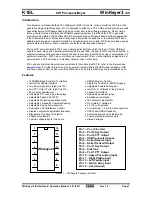
DCU-1 Protocol
The DCU1 protocol is one of the most popular control protocols for antenna rotators. It
allows the control and monitoring of your rotator via packets of commands send to your
computer’s serial port. Normally, these commands are part of a separate program like
LP_Rotor, but also can be built into more complex programs like Ham Radio Deluxe, or
DXView.
There are three command frames and one character command:
"AM1;" which means start turning
“AP1xxx” which means the new heading is xxx
“AI1;” which means send me your current position
“;” which means stop the rotor
NOTE: Some programs do not use the full DCU-1 protocol. There are some programs
which expect the rotor to turn by ONLY sending the AP1xxx command. The RC1-H
needs both the AP1 and the AM1 commands to begin movement.
Error Messages
There are two error messages shown on the screen: CABLE, and MOTOR.
CABLE
Means that the microprocessor is unable to read the pot inside your rotor. For older
rotors, this means the pot is dirty, corroded or intermittent. You can verify this moving
the rotor with the left or right button and see if the message goes away and the main
position digits start moving again. Another cause of the message CABLE could be a
bad connection either at the rotor or control box end. Your pot is most likely 500 ohms
maximum, down to near zero ohms. If your old Hy-gain controller and rotator worked
fine together, then most of the time all it takes to correct this problem is to double check
all cable connections. For the Ham series, measure between pins 1 and 3 on your rotor
cable connector.
MOTOR
Means that the microprocessor has not detected enough movement of your rotator
motor within a few seconds. This could be caused by high winds or a cable has caught,
or the mast is slipping in the rotor mast clamp. Alternatively, this message could also
indicate an open circuit in the motor wiring. For the Ham series you have the
complication of several factors: motor, brake, and motor capacitor. For the Ham series,
pin 1 and pin 2 control the brake: 24 VAC supplied releases the brake, pins 4 and 8 are
the motor capacitor, pin 5 motor right, and pin 6 motor left. If the rotor functioned before
the RC1-H installation, then re-check all connections and compare them against
readings in the Troubleshooting section of the original rotor manual.
LEFT STOP and RIGHT STOP messages (Version 1.4 and above) tell you that you
have hit the left or right mechanical stops in your rotor.






























